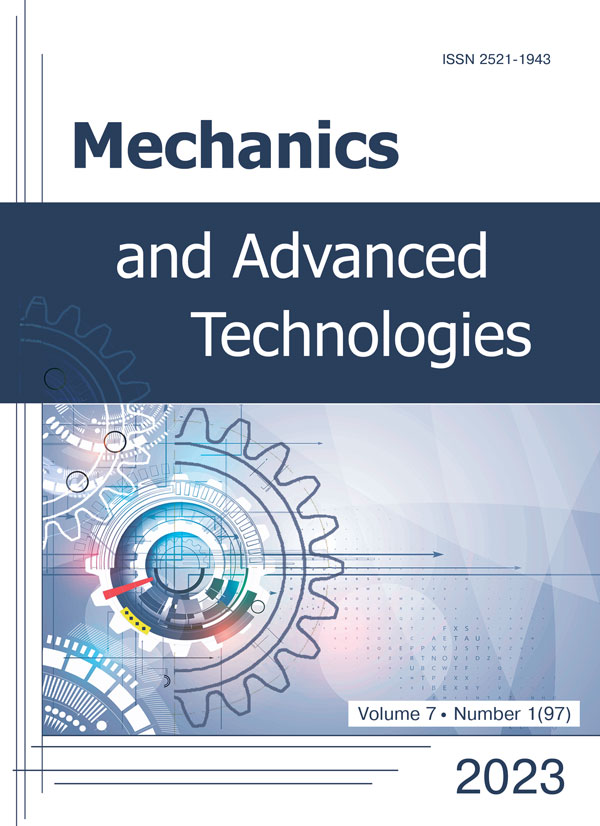Analysis of the forces acting from the side of the magneto-abrasive tool on parts being machined during magneto-abrasive machining in conditions of the annular bath with large working gaps
DOI:
https://doi.org/10.20535/2521-1943.2023.7.1.271548Keywords:
Magneto-abrasive machining, friction force, drag force, magneto-abrasive tool, magnetic inductionAbstract
Background. For effective magneto-abrasive machining (MAM) of complex-shaped parts, comprehensive information is needed on the processes that occur when the magneto-abrasive tool (MAT) contacts with the surfaces being machined. Effective magneto-abrasive machining occurs in the presence of sufficient values of the normal and tangential components of the interaction forces between the MAT and the machined surfaces and the powder mixing during machining. Previously carried out analytical studies of dynamic parameters did not take into account the real conditions of the interaction of grains and their groups with machined surfaces.
Objective. Complex analysis of the processes that occur during magneto-abrasive machining of parts made from different types of materials, based on the results of the study of the friction forces between the magneto-abrasive tool and the surface being machined and the drag forces during the movement of parts in the working zone of the machine.
Methods. To achieve the set goal, the forces acting on the samples during their magneto-abrasive machining were measured with subsequent analytical analysis.
Results. The complex analysis of the processes occurring during MAM in conditions of the annular working zone with large working gaps of parts made of various materials was carried out based on the results of the study of the friction and drag forces that occur when the part moves relative to the magneto-abrasive tool.
Conclusions. It has been determined that when machining non-magnetic samples at the constant value of the magnetic field in the working zone, the specific drag forces are practically independent of the shape of the used powder. According to the analytical representation of the friction and drag forces, their ratio between their specific values was calculated. By the nature of the change in this ratio, it was found that it decreases with an increase in the velocity of samples movement along the working zone, and with an increase in the angular velocity of rotation of the samples around its axis, this value increases in the studied velocity range. It has been determined that at the velocity of movement along the working zone of 2.2 m/s, there is a slight increase in the ratio between the specific forces of friction and drag, which is associated with the action of ponderomotive forces that appear near the surface of the machined parts and lead to an increase in local magnetic forces in these zones.
References
- V. S. Mayboroda, I. V. Slobodyanyuk and D. Yu. Dzhuliy, Magnitno-abrazivnaya obrabotka detaley slozhnoy formy. Zhitomir: Ruta, 2017, 272 p.
- V. S. Mayboroda, Osnovy stvorennya i vykorystannya poroshkovoho mahnitno-abrazyvnoho instrumentu dlya finishnoyi obrobky fasonnykh poverkhon, Dr. dissertation, National Technical University of Ukraine “Kyiv Polytechnic Institute”, Kyiv, 2001, 403 p.
- I. V. Tkachuk, Formuvannya mahnitno-abrazyvnoho instrumentu zi stabilnymy vlastyvostyamy v robochykh zazorakh kiltsevoho typu, Ph.D. dissertation, National Technical University of Ukraine “Kyiv Polytechnic Institute”, Kyiv, 2015.
- P. Singh and P. Kumar, “Effect of Rotation Speed and Grit Size in Magnetic Abrasive Finishing of Inner Surface of Brass (CuZn35) Pipe”, International Journal of Surface Engineering & Materials Technology, vol. 6, no. 1. pp. 44–48, 2016. Available: https://www.somme.in/admin/upload/pdf/IJSEMT%20Vol%206%20No%201%20-%20Final-44-48.pdf.
- V. S. Maiboroda, K. O. Zastavskiy and R. B. Zhuk, “Characteristics of the interaction between magnetic-abrasive tool and a processed surface in a circular work zone”, Technical Engineering, no. 2(88), pp. 3–13, 2021. DOI: https://doi.org/10.26642/ten-2021-2(88)-3-13.
- V. Maiboroda, D. Dzhulii, Y. Besarabets, I. Slobodianiuk and K. Zastavskyi, “Investigation of the drag forces arising in the magneto-abrasive tool during the finishing of cylindrical parts in the annular bath”, Bulletin of the National Technical University "Kharkiv Polytechnic Institute". Series: Techniques in a machine industry, no. 2, pp. 16–22, 2022. DOI: https://doi.org/10.20998/2079-004X.2022.2(6).03.
- M. S. Uddin, V. Santos and R. Marian, “Interplay of process variables in magnetic abrasive finishing of AISI 1018 steel using SiC and Al2O3 abrasives”, Journal of Manufacturing and Materials Processing, vol. 3, no. 2, p. 29, 2019. DOI: https://doi.org/10.3390/jmmp3020029.
- N. S. Khomich, Magnitno-abrazivnaya obrabotka izdeliy: monografiya. Minsk: BNTU, 2006, 217 p.
- T. C. Kanish, S. Narayanan, P. Kuppan and S. D. Ashok, “Investigations on the finishing forces in Magnetic Field Assisted Abrasive Finishing of SS316L”, Procedia Engineering, vol. 174, pp. 611–620, 2017. DOI: https://doi.org/10.1016/j.proeng.2017.01.196.
- T. C. Kanish, S. Narayanan, P. Kuppan and S. D. Ashok, “Experimental Investigations on Magnetic Field Assisted Abrasive Finishing of SS 316L”, Procedia Manufacturing, vol. 30, pp. 276–283, 2019. DOI: https://doi.org/10.1016/j.promfg.2019.02.040.
- R. Sharma and H. Bhardwaj, “Internal Finishing of Stainless Steel Cylinder using Magnetic Abrasive Finishing Method”, International Journal of Scientific Research and Education, vol. 2, no. 8, pp. 1512–1521, 2014.
Downloads
Published
How to Cite
Issue
Section
License
Copyright (c) 2023 Віктор Майборода, Дмитро Джулій, Костянтин Заставський

This work is licensed under a Creative Commons Attribution 4.0 International License.
Authors who publish with this journal agree to the following terms:
- Authors retain copyright and grant the journal right of first publication with the work simultaneously licensed under CC BY 4.0 that allows others to share the work with an acknowledgement of the work's authorship and initial publication in this journal.
- Authors are able to enter into separate, additional contractual arrangements for the non-exclusive distribution of the journal's published version of the work (e.g., post it to an institutional repository or publish it in a book), with an acknowledgement of its initial publication in this journal.
- Authors are permitted and encouraged to post their work online (e.g., in institutional repositories or on their website) prior to and during the submission process, as it can lead to productive exchanges, as well as earlier and greater citation of published work











